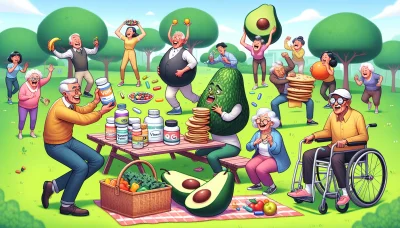What foods are high in fiber but low in carbs Quiz
Test Your Knowledge
Question of
Understanding Fiber and Carbs
The Role of Fiber in Your Diet
Fiber is a plant-based nutrient that is essential for a healthy digestive system. Unlike other food components, fiber isn't digested by your body. Instead, it passes relatively intact through your stomach, small intestine, and colon, and out of your body. This process aids in regular bowel movements and maintains bowel health.
There are two types of fiber: soluble and insoluble. Soluble fiber dissolves in water to form a gel-like material, which can help lower blood cholesterol and glucose levels. Insoluble fiber promotes the movement of material through your digestive system and increases stool bulk, so it can be beneficial to those who struggle with constipation or irregular stools.
Health Benefits of High-Fiber Foods
High-fiber foods have numerous health benefits including the reduction of heart disease risk. They also play a role in weight management by helping you feel full longer after eating. Fiber-rich diets are linked to a lower risk of developing certain types of cancers, particularly colon cancer, due to their role in keeping the digestive system healthy.
Eating high-fiber foods can also aid in controlling blood sugar levels. For people with diabetes, fiber particularly soluble fiber can slow the absorption of sugar and improve blood sugar levels. A healthy diet that includes insoluble fiber may also reduce the risk of developing type 2 diabetes.
Daily Recommended Fiber Intake
The daily recommended intake of fiber varies depending on age and gender. Women under 50 should aim for 25 grams per day, while men under 50 need about 38 grams. For women and men over 50, the daily recommended amount drops to 21 grams for women and 30 grams for men due to decreased food consumption.
To meet these recommendations, include a variety of fiber-rich foods in your diet such as fruits, vegetables, whole grains, legumes, nuts, and seeds. Gradually increasing your intake can help prevent digestive discomfort as your body adjusts to more fiber.
Identifying Low-Carb Foods
Low-carb diets are often adopted for weight loss and health improvement. Identifying low-carb foods is central to adhering to such diets. Generally speaking, most meats, cheeses, fish, eggs, and select dairy products are low in carbohydrates while providing essential proteins and fats.
Vegetables also play a crucial part in a low-carb diet with leafy greens like spinach, kale, and lettuce being particularly low in carbs. Other low-carb vegetable options include broccoli, cauliflower, zucchini, and bell peppers which provide vital nutrients without excessive carbohydrate content.
The Importance of Low-Carb Diets for Weight Management
Low-carb diets have been shown to be effective for weight loss as they promote greater satiety compared to high-carb diets. By reducing carb intake, the body is forced to burn stored fat for energy instead of sugars from carbohydrates. This metabolic state is known as ketosis.
In addition to weight loss benefits, low-carb diets may improve blood sugar control, reduce triglyceride levels, and increase 'good' HDL cholesterol levelsfactors that contribute to better overall heart health.
How to Recognize Hidden Carbs in Foods
- Read Nutrition Labels: Always check the total carbohydrate content listed on packaging which includes sugars, complex carbohydrates, and dietary fibers.
- Avoid Processed Foods: Many processed foods contain added sugars and fillers that increase carb content; opt for whole foods wherever possible.
- Beware of Low-Fat Products: Products labeled as 'low-fat' often replace fats with carbs from sugar or starches to maintain flavor.
- Watch Out for Sugary Drinks: Beverages like soda and fruit juice can be high in carbs from added sugars; choose water or unsweetened alternatives instead.
- Understand Serving Sizes: The listed carb content might be per serving rather than per packageensure you're calculating based on how much you will actually consume.
- Educate Yourself on Carb-Dense Foods: Grains (even whole grains), starchy vegetables like potatoes or corns, beans/legumes can have higher carb counts than expected.
High-Fiber, Low-Carb Foods to Include in Your Diet
Vegetables High in Fiber and Low in Carbs
When you're aiming to stay low on carbs yet high on fiber, vegetables are your best friends! They're not just packed with nutrients; they're also incredibly versatile. You can easily incorporate them into any meal, ensuring that you stay full and energized without the carb overload. Vegetables are the cornerstone of a balanced diet, offering a plethora of vitamins and minerals while keeping your digestive system running smoothly.
Among the vegetable kingdom, some stand out as the champions of fiber while keeping those pesky carbs at bay. These veggies can be enjoyed raw, sauted, roasted, or steamed. They're perfect for adding bulk and nutrition to your meals without the guilt. Remember, choosing vegetables that are both high in fiber and low in carbohydrates is a smart strategy for managing weight and promoting overall health.
Leafy Greens and Their Nutritional Value
Leafy greens are a nutritional powerhouse that should be a staple in your diet. Spinach, kale, and Swiss chard are loaded with fiber and almost negligible carbs. These greens have the power to not only nourish your body but also protect it against diseases by packing antioxidants, vitamins A, C, E, and K. They're like the superheroes of the vegetable world!
Introducing leafy greens into your daily routine can be as simple as tossing a handful into smoothies or layering them in sandwiches. Their subtle taste makes them an easy addition to any dish, elevating its nutritional profile without overpowering other flavors.
Cruciferous Vegetables for Balanced Meals
Cruciferous vegetables such as broccoli, cauliflower, and Brussels sprouts are renowned for their high-fiber content with minimal carbohydrate impact. They provide essential nutrients like folate and vitamin K while supporting detoxification processes in your body. These veggies are truly a win-win!
Incorporating cruciferous vegetables into your meals adds not just nutrition but also variety in texture and flavor. Roast them to bring out their natural sweetness or stir-fry with spices to create a mouthwatering side dish that complements any main course.
Nuts and Seeds with Optimal Fiber-to-Carb Ratios
Nuts and seeds may be small in size but they're gigantic when it comes to nutritional benefits! They are the perfect snack for anyone looking to increase fiber intake without adding too many carbs. Plus, they come packed with healthy fats that keep you satisfied longer. Nuts and seeds are ideal for on-the-go snacking or as an addition to meals for that extra crunch.
With nuts and seeds, moderation is key due to their high-calorie countyet they remain an excellent choice for smart snacking. They offer a great way to enhance dishes with texture while providing sustained energy release throughout the day.
Almonds, Chia Seeds, and Their Health Advantages
Almonds are more than just a tasty snack; they're loaded with fiber yet surprisingly low in digestible carbs. They also boast high levels of vitamin E which is great for skin health. On top of that, chia seeds are another superfood that packs an impressive amount of fiber with very few carbsand let's not forget their high omega-3 fatty acid content!
Add almonds to your yogurt or oatmeal for a satisfying crunch or soak chia seeds overnight for a delightful pudding-like treat packed with nutrients. These small additions can make big strides towards meeting your dietary goals.
Incorporating Flaxseeds and Walnuts into Your Diet
Flaxseeds are fiber-rich champions with a very low carb countmaking them an excellent addition to any diet focused on gut health and blood sugar control. Similarly, walnuts not only add a delicious crunch but also contribute valuable antioxidants and omega-3s crucial for brain health.
To make the most out of flaxseeds and walnuts:
- Grind flaxseeds: To improve absorption of nutrients since whole flaxseeds may pass through undigested.
- Add walnuts: To salads or baked goods for texture or enjoy them as part of homemade trail mix.
- Mix into batters: For pancakes or muffins to increase their fiber content subtly.
- Create seed-crusts: For meats or fish by combining ground flaxseeds with herbs and seasonings before baking.
- Sprinkle over breakfast bowls: Such as oatmeal or yogurt for an added nutrient boost.
Planning Your High-Fiber, Low-Carb Diet
Creating a Balanced Meal Plan
Embarking on a high-fiber, low-carb diet requires a strategic approach to ensure you get all the necessary nutrients while keeping your carb intake in check. It's crucial to include a variety of foods like leafy greens, lean proteins, and high-fiber fruits to maintain balance. Planning ahead can prevent dietary slip-ups and keep you on the path to achieving your health goals.
Diversifying your diet is key; incorporate fiber-rich vegetables such as broccoli and Brussels sprouts with every meal. Lean proteins like chicken or fish complement these veggies, providing the body with essential amino acids without excess carbs. Remember, fats are your friends here think avocados, nuts, and seeds for energy that aligns with your low-carb criteria.
Sample Meal Planning for a Week
To get started, outline a weekly menu that alternates between various protein sources and an abundance of non-starchy vegetables. For example, start Monday with a spinach omelet, have grilled salmon with asparagus for lunch on Wednesday, and enjoy a hearty beef and vegetable stir-fry on Friday night. This rotation ensures you won't tire of your meals while keeping carbs at bay.
Remember breakfast is pivotal; opt for high-fiber cereals or smoothies with flaxseeds. Lunches could be salads packed with greens and dinner might feature cauliflower rice or zucchini noodles as satisfying but low-carb alternatives to grains. The key is consistency in varying your meals within the diet's framework to sustain interest and nutritional value.
Tips for Portion Control and Meal Timing
- Eat slowly and mindfully to recognize fullness cues and avoid overeating.
- Use smaller plates to naturally reduce serving sizes without feeling deprived.
- Plan meals and snacks at regular intervals throughout the day to curb hunger and prevent binging.
- Stay hydrated sometimes thirst is mistaken for hunger, leading to unnecessary snacking.
- Avoid distractions during meals so you can monitor your intake more effectively.
Snack Ideas That Fit the Bill
Healthy Snack Options for On-the-Go
Maintaining your high-fiber, low-carb diet doesn't have to fall by the wayside when you're out and about. Pre-packaged almond butter packets pair excellently with celery sticks or apple slices for a quick snack that satisfies both criteria. Similarly, a small bag of mixed nuts provides healthy fats along with fiber, keeping you satiated until your next meal.
For those who prefer something savory, cheese sticks or Greek yogurt can be convenient options that fit within your macronutrient goals. Just check labels carefully not all yogurts are created equal! Look for varieties that boast higher protein levels while staying low in carbs to align with your dietary plan.
Preparing Snacks at Home to Maintain Diet Goals
Homemade snacks can be both rewarding and better aligned with dietary needs since you control the ingredients. Think homemade kale chips baked with olive oil and sea salt they're crunchy, flavorful, and full of fiber. Another excellent option is chia pudding made with almond milk; it's customizable in flavor while being packed with nutrients.
Lettuce wraps filled with turkey breast and avocado or cottage cheese topped with raspberries also make delicious home-prepped snacks that won't derail your efforts. The aim is to create snacks that are not only tasty but also provide sustained energy without an overload of carbohydrates.
Understanding Diets: Keto and Paleo Perspectives
The Ketogenic Diet Explained
The ketogenic diet is a revolutionary approach to weight loss and health improvement, focusing on high-fat, moderate protein, and low-carbohydrate intake. It's designed to switch your body's primary energy source from glucose to ketones, fats' by-products. This shift in metabolism can lead to rapid weight loss and has been linked with various health benefits including improved insulin sensitivity and brain function.
Transitioning to the ketogenic diet requires a significant reduction in carbohydrate consumption, which can initially be challenging. However, the incorporation of healthy fats from sources such as avocados, nuts, and olive oil can make this lifestyle both sustainable and enjoyable. Its essential to understand that keto is not just about cutting carbs but also about finding a balance that works for your body.
How Ketosis Works for Weight Loss
Ketosis is a metabolic state where the body efficiently burns fat for fuel instead of carbohydrates. Achieving ketosis involves maintaining a strict ratio of fats, proteins, and carbs that encourages the body to switch its energy source. This process results in the breakdown of fat stores, leading to potential weight loss and improvements in overall health markers like blood sugar levels.
When in ketosis, many individuals report increased energy levels and a suppressed appetite, which can further contribute to weight loss. Its crucial to monitor your progress and adjust your diet accordingly since each person's body responds differently to carbohydrate restriction.
Adapting to a Keto Lifestyle with High-Fiber Choices
While fiber is often associated with carbohydrates, it's possibleand importantto incorporate high-fiber foods into a ketogenic diet. Fiber aids digestion and helps maintain gut health without kicking you out of ketosis since it doesn't spike blood sugar levels. Foods like chia seeds, flaxseeds, and certain low-carb vegetables are excellent choices for adding fiber while staying within keto guidelines.
Maintaining a high-fiber diet on keto can be challenging but is achievable with careful planning. Including a variety of fiber-rich foods not only supports digestive health but also enhances satiety between mealsa key component for sticking with any dietary plan long-term.
The Paleo Diet and Fiber Intake
Principles of the Paleo Diet
The Paleo diet takes inspiration from our hunter-gatherer ancestors, emphasizing whole foods such as lean meats, fish, fruits, vegetables, nuts, and seeds while excluding processed foods, grains, legumes, and dairy. Its premise lies in the belief that modern eating habits are mismatched with our evolutionary biology and that by returning to a more 'natural' diet we can improve our health.
This dietary approach not only focuses on eliminating processed foods but also encourages the consumption of nutrient-dense options that provide essential vitamins and minerals. While it restricts certain food groups like grains and legumeswhich are common sources of fiberthere are ample opportunities within Paleo guidelines to consume sufficient fiber through other means.
Balancing Low-Carb and High-Fiber Foods in Paleo
Finding the right balance between low-carb intake and high dietary fiber is a key aspect of following the Paleo diet successfully. Vegetables such as broccoli, Brussels sprouts, and leafy greens are staples that offer both low net carbohydrates and high fiber content. Berries can also be included for their antioxidant properties while keeping carb intake in check.
- Select fibrous fruits like apples or pears for their skin which contains considerable amounts of fiber.
- Incorporate seeds like pumpkin or sunflower seeds as snacks or salad toppings for an added fiber boost.
- Eat plenty of non-starchy vegetables throughout the day; they're packed with nutrients in addition to being excellent sources of fiber.
- Avoid falling into the trap of "Paleo-approved" processed foods which may lack fiber; always opt for whole food options where possible.
- Stay hydrated; water helps dietary fiber do its job more effectively within your digestive system.
Focusing on these naturally fibrous food options will help maintain digestive health while adhering to Paleo principles without compromising on carbohydrate restrictions. With thoughtful meal planning, one can enjoy a diverse range of flavors while meeting all nutritional needs within this ancient-inspired framework.
Challenges of Combining High Fiber with Low Carbs
Common Pitfalls to Avoid in Your Diet
Embarking on a high-fiber, low-carb diet can be a game-changer for your health, but watch out for common mistakes! People often replace carbs with unhealthy fats instead of fiber-rich veggies. Remember, it's about finding the right balance between good fats and fiber while keeping carbs in check. Don't let hidden sugars in "low-carb" products derail your progress either always read the labels!
Maintaining variety in your diet is critical to avoid nutrient deficiencies and boredom. It's easy to fall into a routine of eating the same meals, which can lead to missing out on essential nutrients. Diversify your plate with different high-fiber vegetables and proteins to keep things interesting and nutritionally balanced. Stay vigilant about portion sizes too; even low-carb foods can cause weight gain if consumed in excess.
- Avoid replacing carbs with unhealthy fats focus on fiber-rich vegetables.
- Read labels carefully to steer clear of hidden sugars in "low-carb" products.
- Ensure variety in your meals to prevent nutrient deficiencies and meal fatigue.
- Monitor portion sizes as even low-carb foods can contribute to weight gain when overeaten.
Overcoming Cravings for High-Carb Foods
Battling cravings for bread, pasta, and sugary treats is a real struggle when switching to a low-carb lifestyle. To conquer these urges, stock up on satisfying low-carb snacks like nuts or cheese. Planning your meals ahead can also prevent last-minute carb-heavy choices. When cravings hit, reach for high-fiber alternatives that offer similar textures or flavors without the carb overload.
Your mindset is powerful remind yourself why you chose this dietary path. Visualize your health goals and the benefits you'll reap from sticking to high-fiber, low-carb foods. If cravings persist, consider allowing yourself a small treat within your carb limit occasionally it can make adherence more sustainable in the long run.
Dealing with Digestive Issues from Sudden Fiber Increase
Jumping into a high-fiber diet can shock your digestive system! To minimize issues like bloating and gas, increase fiber intake gradually. Introduce fiber-rich foods slowly over several weeks to give your body time to adjust. A sudden leap in fiber can be tough on digestion, so pace yourself for a smoother transition.
In addition to pacing your fiber intake, consider incorporating fermented foods like yogurt or kefir into your diet. These contain probiotics that support gut health and can help manage digestive discomfort associated with increased fiber consumption. Keep an eye on how different foods affect you and adjust accordingly.
Staying Hydrated and Managing Electrolytes
The Importance of Water in High-Fiber Diets
Water is the unsung hero when eating high-fiber! Fiber absorbs water, so increasing hydration is crucial to prevent constipation and maintain bowel regularity. Aim to drink plenty of fluids throughout the day it's vital for moving that fiber through your system effectively. Don't wait until you're thirsty; keep that water bottle handy at all times!
If you're struggling with dry mouth or headaches, it could be a sign you're not drinking enough water for your high-fiber regimen. Listen to your body's signals and respond by upping fluid intake immediately. Herbal teas and infused waters are excellent ways to stay hydrated while keeping things flavorful.
Electrolyte Balance on Low-Carb Diets
A low-carb diet may cause an initial loss of water weight along with it, precious electrolytes like sodium, potassium, and magnesium might get flushed out too quickly. To counteract this imbalance, consider adding a pinch of salt to your water or eating electrolyte-rich foods such as avocados and leafy greens. Supplements can also help but consult with a healthcare provider before starting any new regimen.
Evaluating your electrolyte levels regularly is important as imbalances can lead to fatigue and muscle cramps signs not to ignore! Making small adjustments like salting food a bit more than usual or choosing mineral waters can make all the difference in maintaining equilibrium while reaping the benefits of a high-fiber, low-carb diet.
Long-Term Success with High-Fiber, Low-Carb Eating
Monitoring Your Progress and Health Markers
Achieving long-term success with a high-fiber, low-carb diet is contingent on consistent monitoring of both dietary intake and health indicators. Regular check-ups and tracking can help you adjust your diet to better meet your health goals.
Key health markers such as weight, body composition, and energy levels are essential barometers of the effectiveness of your dietary regimen. Maintaining detailed records offers invaluable insights into how your body responds to changes in your diet.
Tracking Fiber and Carb Intake Effectively
To maintain a successful balance, meticulous tracking of fiber and carb intake is crucial. Utilize apps or food diaries to ensure you're meeting your dietary targets for optimal health benefits.
Understanding the net carbs - total carbohydrates minus fiber - can guide you in making informed choices about the foods you consume. Aim for nutrient-dense options that provide ample fiber while keeping carbs in check.
Understanding the Impact on Blood Sugar and Cholesterol Levels
The impact of a high-fiber, low-carb diet on blood sugar stabilization is profound. By minimizing insulin spikes, this dietary approach can be especially beneficial for individuals managing diabetes or insulin resistance.
In addition to blood sugar control, a high-fiber intake can contribute to improved cholesterol levels. Soluble fiber, in particular, has been shown to reduce LDL cholesterol, thus supporting cardiovascular health.
Adapting Recipes for Better Nutrition
Adapting traditional recipes to fit a high-fiber, low-carb profile not only enhances nutritional value but also diversifies your meal plan. Creative substitutions can transform even the most indulgent dishes into healthy staples.
An adventurous spirit in the kitchen can lead to discovering new flavors while maintaining dietary discipline. A willingness to experiment is key to keeping meals exciting and nutritionally sound.
Finding Alternatives to High-Carb Ingredients
- Replace white rice with cauliflower rice for a low-carb alternative that's rich in nutrients.
- Opt for spiralized vegetables like zucchini instead of traditional pasta to boost fiber content.
- Use lettuce wraps in place of bread or tortillas for sandwiches and tacos to cut down on carbs while adding crunch and freshness.
- Select nuts and seeds over croutons as salad toppings for added texture without the excess carbohydrates.
- Incorporate avocados into meals; they're high in healthy fats and fiber but low in net carbs.
- Choose berries over other fruits as they offer sweetness with fewer carbs and a high dose of dietary fiber.
Experimenting with Fiber-Rich Flours and Sweeteners
Baking with flours such as almond or coconut flour can significantly reduce carb content while adding fiber. These alternatives produce delicious results that align with a low-carb eating plan.
Natural sweeteners like stevia or erythritol are excellent choices for reducing sugar intake without sacrificing sweetness. They allow for indulgence without deviating from a low-carb commitment.












